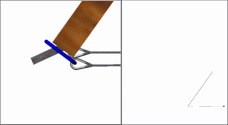
The trebuchet was originally constructed entirely of wood, utilizing mortise and tenon type joints for its support members and early variations of the dove-tail type splicing for members of extended length. This resulted in caravans of Horse drawn carts being necessary to transport the entire apparatus to its point of assembly. A more common method was to simply spend a week or so gathering timbers on location when laying siege to a city. This was preferable because it freed up carts and horses for the attacking army so they could bring more provisions and supplies, thus extending their range and speed.
Later trebuchets utilized steel and iron gusset plates to strengthen wooden joints, along with steel rods for the fulcrum. Utilizing ropes to hold the structure together and to prevent splintering of the wood at key joints. Tar and pitch were often used to prevent the trebuchet from weakening due to the elements and weather to which it was exposed during times of siege.